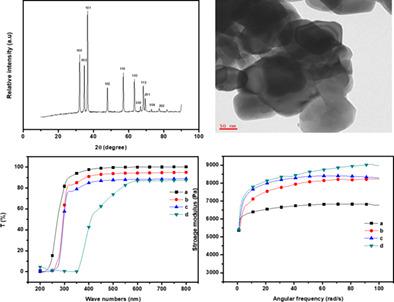当前位置:
X-MOL 学术
›
Polym. Eng. Sci.
›
论文详情
Our official English website, www.x-mol.net, welcomes your
feedback! (Note: you will need to create a separate account there.)
Barrier, rheological, and antimicrobial properties of sustainable nanocomposites based on gellan gum/polyacrylamide/zinc oxide
Polymer Engineering and Science ( IF 3.2 ) Pub Date : 2021-08-11 , DOI: 10.1002/pen.25773 Rukmanikrishnan Balasubramanian 1 , Ramalingam Srinivasan 2 , Jaewoong Lee 1
Polymer Engineering and Science ( IF 3.2 ) Pub Date : 2021-08-11 , DOI: 10.1002/pen.25773 Rukmanikrishnan Balasubramanian 1 , Ramalingam Srinivasan 2 , Jaewoong Lee 1
Affiliation

|
In this study, we used a solution casting method to prepare gellan gum (G)-based ternary nanocomposite films containing polyacrylamide (P) and zinc oxide (ZnO) nanoparticles. All composites were prepared using the chemical cross-linker N,N-methylenebisacrylamide. The nanocomposites were characterized using Fourier transform infrared (FTIR) spectroscopy, X-ray diffraction, and scanning electron microscopy. Attenuated total reflectance FTIR revealed strong hydrogen bonding interactions among gellan gum, polyacrylamide, and ZnO, which enhanced the physiochemical, thermal, and mechanical properties of the GPZnO nanocomposites. The addition of ZnO nanoparticles increased the glass transition temperature (Tg: 181.8–196.3°C), thermal stability (T5%: 87.8–96.5°C), and char yield (23.9–29.1%) of the GP composite films, as well as their the tensile strength (from 33.5 to 43.8 MPa) and ultraviolet (UV) blocking properties (~99.2% protection against UVB [280–320 nm]). ZnO significantly influenced the rheological properties of the GP composite. The prepared GP and GPZnO nanocomposites exhibited shear thinning behavior and their viscosities decreased when there is an increase in shear rate. Storage and loss modulus increased with frequency with the addition of ZnO nanoparticles. The GPZnO films exhibited reduced hydrophilicity, moisture content, and water barrier properties compared with the GP film. The GPZnO nanocomposites exhibited effective antimicrobial activity against six different pathogens. The prepared GPZnO films could be useful in biodegradable packaging applications.
中文翻译:

基于结冷胶/聚丙烯酰胺/氧化锌的可持续纳米复合材料的阻隔、流变和抗菌性能
在这项研究中,我们使用溶液浇铸方法制备了含有聚丙烯酰胺 (P) 和氧化锌 (ZnO) 纳米颗粒的结冷胶 (G) 基三元纳米复合薄膜。所有复合材料均使用化学交联剂N , N - 亚甲基双丙烯酰胺制备。使用傅里叶变换红外 (FTIR) 光谱、X 射线衍射和扫描电子显微镜对纳米复合材料进行表征。衰减全反射 FTIR 揭示了结冷胶、聚丙烯酰胺和 ZnO 之间的强氢键相互作用,这增强了 GPZnO 纳米复合材料的理化、热和机械性能。ZnO 纳米颗粒的添加提高了玻璃化转变温度 ( T g : 181.8–196.3°C)、热稳定性 (Ť 5%: 87.8–96.5°C) 和 GP 复合薄膜的炭化率 (23.9–29.1%),以及它们的拉伸强度(从 33.5 到 43.8 MPa)和紫外线 (UV) 阻挡性能(~99.2% 的防护) UVB [280–320 nm])。ZnO 显着影响 GP 复合材料的流变性能。制备的 GP 和 GPZnO 纳米复合材料表现出剪切稀化行为,当剪切速率增加时,它们的粘度降低。随着 ZnO 纳米颗粒的加入,储能模量和损耗模量随频率增加。与GP薄膜相比,GPZnO薄膜表现出降低的亲水性、水分含量和阻水性能。GPZnO 纳米复合材料对六种不同的病原体表现出有效的抗菌活性。制备的 GPZnO 薄膜可用于可生物降解的包装应用。
更新日期:2021-10-01
中文翻译:

基于结冷胶/聚丙烯酰胺/氧化锌的可持续纳米复合材料的阻隔、流变和抗菌性能
在这项研究中,我们使用溶液浇铸方法制备了含有聚丙烯酰胺 (P) 和氧化锌 (ZnO) 纳米颗粒的结冷胶 (G) 基三元纳米复合薄膜。所有复合材料均使用化学交联剂N , N - 亚甲基双丙烯酰胺制备。使用傅里叶变换红外 (FTIR) 光谱、X 射线衍射和扫描电子显微镜对纳米复合材料进行表征。衰减全反射 FTIR 揭示了结冷胶、聚丙烯酰胺和 ZnO 之间的强氢键相互作用,这增强了 GPZnO 纳米复合材料的理化、热和机械性能。ZnO 纳米颗粒的添加提高了玻璃化转变温度 ( T g : 181.8–196.3°C)、热稳定性 (Ť 5%: 87.8–96.5°C) 和 GP 复合薄膜的炭化率 (23.9–29.1%),以及它们的拉伸强度(从 33.5 到 43.8 MPa)和紫外线 (UV) 阻挡性能(~99.2% 的防护) UVB [280–320 nm])。ZnO 显着影响 GP 复合材料的流变性能。制备的 GP 和 GPZnO 纳米复合材料表现出剪切稀化行为,当剪切速率增加时,它们的粘度降低。随着 ZnO 纳米颗粒的加入,储能模量和损耗模量随频率增加。与GP薄膜相比,GPZnO薄膜表现出降低的亲水性、水分含量和阻水性能。GPZnO 纳米复合材料对六种不同的病原体表现出有效的抗菌活性。制备的 GPZnO 薄膜可用于可生物降解的包装应用。











































 京公网安备 11010802027423号
京公网安备 11010802027423号